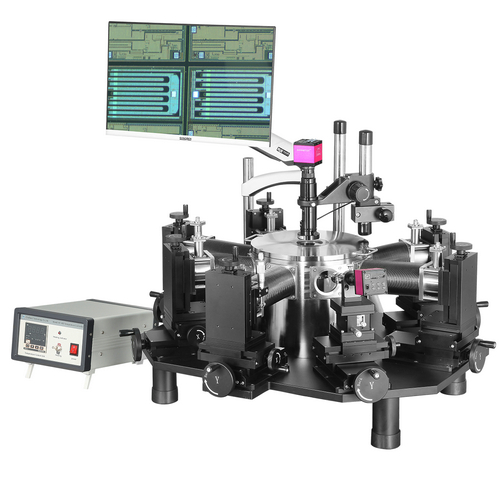Cindbest Technology takes you to understand the detailed parameters of high and low temperature vacuum probe stations
The main technical parameters of these two devices include chamber size, sample stage size, observation window size, vacuum degree, probe arm interface, other interfaces (telecommunications interface, vacuum interface, fiber optic interface, cold source interface), cooling method, control method, temperature range, temperature control resolution, stability, etc.
Cavity and sample table: CGO-2 and CGO-4 have sample table sizes of 2 inches and 4 inches, respectively, and use spring-loaded tabs to secure the sample.

Observation window: The observation window size is 2 inches and 4 inches, respectively, for observing the sample.
Vacuum degree: Both devices can achieve a vacuum degree of 10-6torr, ensuring a high purity testing environment.
Probe arm interface: up to 6 probe arm interfaces can be connected to meet various testing requirements.
Other interfaces: The equipment provides telecommunications interfaces, vacuum interfaces, fiber optic interfaces, and cold source interfaces, enhancing the versatility and flexibility of the equipment.
Refrigeration method and temperature range: Liquid nitrogen or liquid helium refrigeration is used, with temperature ranges covering 77K~450K (CGO-2) and 4.5K~450K (CGO-4).
Control mode: CGO-2 adopts open-loop manual control mode, while CGO-4 adopts closed-loop automatic control mode.
Microscope and probe head: Both devices are equipped with a microscope and probe head, with X-Y-Z travel and structural features, as well as movement accuracy. In addition, the microscope is equipped with an LED ring light source and a CCD camera.
Probe fixture: Provides a variety of cable types, leakage accuracy, and fixing methods, and comes equipped with a variety of connector types.
Probe characteristics: Supports a frequency range of DC-67GHZ, with different diameters of tip (from 0.2um to 100um), as well as tungsten steel and beryllium copper materials.
Vacuum components and cold source components: The equipment includes a molecular pump set or mechanical pump as a vacuum component, and a liquid nitrogen tank, liquid helium tank, or refrigerator as a cold source component.
Size and weight: The device has a size of 730mm long, 750mm wide, and 1265mm high, and weighs approximately 100 kilograms.
In summary, CGO-2 and CGO-4 are two powerful and highly configurable semiconductor test devices suitable for a variety of high-precision test applications, such as testing the resistance, capacitance, inductance, quality factor, and frequency response of electronic components. They are highly customizable and can be configured according to different test requirements.
2016-05-13
GGB RF Probe Selection Method2024-04-07
Principle and Application Fields of Magnetic Field Probe Station2024-04-03
Classification and Corresponding Parameter Explanation of High-Low Temperature Probe Stations2024-04-01
Characteristics and Applications of Waveguide Probes2024-03-27
Classification and Application Scenarios of High-end Probe Stations2024-03-26
What is a DC probe and its application fields?2024-03-25
Probe Station Selection Guide: How to choose the most suitable probe station for your laboratory?2024-03-16
Analysis of High-Temperature Test and Measurement Probe Station System2024-03-11
Probe station: unlocking the infinite possibilities of semiconductor testing2024-03-04
Take you to understand the mid-end probe station and its corresponding technical parameters